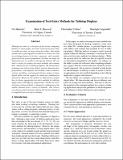Files in this item
Examination of text-entry methods for tabletop displays
Item metadata
| dc.contributor.author | Hinrichs, Uta | |
| dc.contributor.author | Hancock, Mark S. | |
| dc.contributor.author | Collins, Christopher | |
| dc.contributor.author | Carpendale, Sheelagh | |
| dc.date.accessioned | 2015-09-03T12:10:01Z | |
| dc.date.available | 2015-09-03T12:10:01Z | |
| dc.date.issued | 2007-10-10 | |
| dc.identifier | 214033967 | |
| dc.identifier | 5c4c20f1-d390-494f-b953-ebd971e999e7 | |
| dc.identifier | 47949122888 | |
| dc.identifier.citation | Hinrichs , U , Hancock , M S , Collins , C & Carpendale , S 2007 , Examination of text-entry methods for tabletop displays . in Second Annual IEEE International Workshop on Horizontal Interactive Human-Computer Systems, 2007. TABLETOP '07 . IEEE , pp. 105-112 , Second Annual IEEE International Workshop on Horizontal Interactive Human-Computer Systems, 2007. TABLETOP '07 , Newport, RI , United States , 10/10/07 . https://doi.org/10.1109/TABLETOP.2007.10 | en |
| dc.identifier.citation | workshop | en |
| dc.identifier.isbn | 9780769520131 | |
| dc.identifier.other | Bibtex: urn:e24b1930bc40cda2b9c4a8a6588881b0 | |
| dc.identifier.uri | https://hdl.handle.net/10023/7400 | |
| dc.description.abstract | Although text entry is a vital part of day-to-day computing familiar to most people, not much research has been done to enable text entry on large interactive tables. One might assume that a good approach would be to choose an existing technique known to be fast, ergonomic, and currently preferred by the general population, but there are many additional factors to consider in this specific domain. We consider a variety of existing text-entry methods and examine their viability for use on tabletop displays. We discuss these techniques not only in terms of their general characteristics, performance, and adoption, but introduce other evaluative criteria, including: environmental factors unique to large digital tables and the support for multi-user simultaneous interaction. Based on our analysis we illustrate by example how to choose appropriate text-entry methods for tabletop applications with differing requirements, whether by selection from existing methods, or through a combination of desirable elements from a variety of methods. Our criteria can also be used as heuristics during the iterative design of a completely new text-entry technique. | |
| dc.format.extent | 8 | |
| dc.format.extent | 108390 | |
| dc.language.iso | eng | |
| dc.publisher | IEEE | |
| dc.relation.ispartof | Second Annual IEEE International Workshop on Horizontal Interactive Human-Computer Systems, 2007. TABLETOP '07 | en |
| dc.subject | QA75 Electronic computers. Computer science | en |
| dc.subject | Computer Science Applications | en |
| dc.subject | Human-Computer Interaction | en |
| dc.subject.lcc | QA75 | en |
| dc.title | Examination of text-entry methods for tabletop displays | en |
| dc.type | Conference item | en |
| dc.contributor.institution | University of St Andrews. School of Computer Science | en |
| dc.identifier.doi | https://doi.org/10.1109/TABLETOP.2007.10 |
This item appears in the following Collection(s)
Items in the St Andrews Research Repository are protected by copyright, with all rights reserved, unless otherwise indicated.

